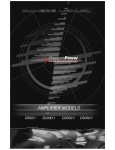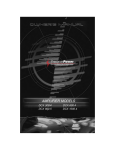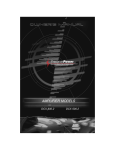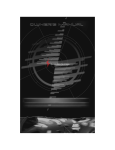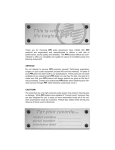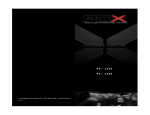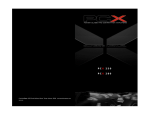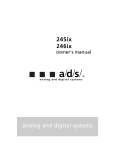Download Directed Electronics A1200/4 Stereo Amplifier User Manual
Transcript
AMPLIFIER MODELS A600/4 A1200/4 TABLE OF CONTENTS Congratulations . . . . . . . . . . . . . . . . . . . . . . . . . . . . . . . . . . . . . . .2 Service . . . . . . . . . . . . . . . . . . . . . . . . . . . . . . . . . . . . . . . . . . . . . .2 Caution . . . . . . . . . . . . . . . . . . . . . . . . . . . . . . . . . . . . . . . . . . . . .2 Features . . . . . . . . . . . . . . . . . . . . . . . . . . . . . . . . . . . . . . . . . . . . .3 CEA Specifications . . . . . . . . . . . . . . . . . . . . . . . . . . . . . . . . . . . .3 Specifications . . . . . . . . . . . . . . . . . . . . . . . . . . . . . . . . . . . . . . . .4 Fuse Requirements . . . . . . . . . . . . . . . . . . . . . . . . . . . . . . . . . . . .5 Amplifier Status LEDs . . . . . . . . . . . . . . . . . . . . . . . . . . . . . . . . . .6 Tools/Parts for Installation . . . . . . . . . . . . . . . . . . . . . . . . . . . . . . .7 Wiring . . . . . . . . . . . . . . . . . . . . . . . . . . . . . . . . . . . . . . . . . . . . . .8 Ground Wiring . . . . . . . . . . . . . . . . . . . . . . . . . . . . . . . . . . . . . . .10 Charging System . . . . . . . . . . . . . . . . . . . . . . . . . . . . . . . . . . . . .11 Current Draw . . . . . . . . . . . . . . . . . . . . . . . . . . . . . . . . . . . . . . . .11 Power Wire Size . . . . . . . . . . . . . . . . . . . . . . . . . . . . . . . . . . . . .12 Power Lock Connectors . . . . . . . . . . . . . . . . . . . . . . . . . . . . . . . .13 Amplifier Bridging . . . . . . . . . . . . . . . . . . . . . . . . . . . . . . . . . . . .13 Mixed Mono Output . . . . . . . . . . . . . . . . . . . . . . . . . . . . . . . . . . .14 A600/4 Front Plate Diagram . . . . . . . . . . . . . . . . . . . . . . . . . . . .15 A600/4 End Plate Diagram . . . . . . . . . . . . . . . . . . . . . . . . . . . . .17 A1200/4 Front Plate Diagram . . . . . . . . . . . . . . . . . . . . . . . . . . .17 A1200/4 End Plate Diagram . . . . . . . . . . . . . . . . . . . . . . . . . . . .19 Inputs . . . . . . . . . . . . . . . . . . . . . . . . . . . . . . . . . . . . . . . . . . . . . .20 A600/4, A1200/4 Block Diagram . . . . . . . . . . . . . . . . . . . . . . . . .21 Advanced Instrumentation Input . . . . . . . . . . . . . . . . . . . . . . . . .22 QBASS . . . . . . . . . . . . . . . . . . . . . . . . . . . . . . . . . . . . . . . . . . . .22 QBASS/QBASS PLUS Specifications . . . . . . . . . . . . . . . . . . . . .23 QBASS PLUS . . . . . . . . . . . . . . . . . . . . . . . . . . . . . . . . . . . . . . .23 TC-X Crossover . . . . . . . . . . . . . . . . . . . . . . . . . . . . . . . . . . . . . .25 Crossover Detent Chart . . . . . . . . . . . . . . . . . . . . . . . . . . . . . . . .26 Input Combine . . . . . . . . . . . . . . . . . . . . . . . . . . . . . . . . . . . . . . .27 Adjusting Input Gain . . . . . . . . . . . . . . . . . . . . . . . . . . . . . . . . . .27 High Mass Internal Heatsink . . . . . . . . . . . . . . . . . . . . . . . . . . . .27 AP-IV Protection Circuit . . . . . . . . . . . . . . . . . . . . . . . . . . . . . . . .27 Troubleshooting . . . . . . . . . . . . . . . . . . . . . . . . . . . . . . . . . . . . . .28 1 CONGRATULATIONS Thank you for choosing Precision PowerTM audio equipment. Designed and engineered in the USA, this product combines innovative technology with the finest materials to consistently deliver Absolutely State of the Art™ performance, sound quality, reliability, and value. This Precision PowerTM product reflects our commitment to offer you unparalleled performance and quality for years of dependable service and listening enjoyment. SERVICE Do not attempt to service Precision PowerTM products yourself. Performing maintenance on your audio equipment will void the warranty. Many parts of the Precision PowerTM product are custom built to our specifications. Our factory parts are not made available to anyone else nor are they for sale. Our goal is to make sure that your Precision PowerTM product will always sound as good as the day it was purchased. Contact your Authorized Precision PowerTM Dealer about obtaining any warranty service through Precision PowerTM. (See the Warranty on the outside of the back cover). CAUTION Extended use of a high powered audio system may result in hearing loss or damage. While Precision PowerTM systems are capable of “Concert Level” volumes with incredible accuracy, they are also designed for you to enjoy at more reasonable levels all of the sonic subtleties created by musicians. Please observe all local sound ordinances. 2 FEATURES Advanced Instrumentation Input Stage TC-X Crossover 24dB/Octave; HP/LP/FULL; 30-4kHz Crossover Adaptive PWM Power Supply AP-IV Protection Circuity Fully Complementary Darlington Output Stage QBASSTM Bass Boost (A600/4) QBASS PlusTM Bass Boost (A1200/4) High Voltage Input Capability with -12dB Attenuation Switch Gold Plated RCA Input and Output Connectors PowerLockTM Speaker and Power Wire Connectors Mixed Mono/Stereo Operation WHAT’S INCLUDED Amplifier (with speaker and power plugs mounted) (4) Mounting screws and washers 2mm hex wrench 2.5mm hex wrench 3mm hex wrench CEA SPECIFICATIONS A600/4 Power Output: 50 Watts RMS x 4 at 4 ohms and < 1% THD+N Signal to Noise Ratio: -87 dBA (reference 1 Watt into 4 ohms) Additional Power Output: 80 Watts RMS x 4 at 2 ohm at 14.4 Supply<1% THD+N A1200/4 Power Output: 110 Watts RMS x 4 at 4 ohms and < 1% THD+N Signal to Noise Ratio: -94 dBA (reference 1 Watt into 4 ohms) Additional Power Output: 140 Watts RMS x 4 at 2 ohm at 14.4 Supply<1% THD+N 3 SPECIFICATIONS Nominal Power Ratings MODEL A600/4 A1200/4 4ohm STEREO 4 X 50 4 X 100 2ohm STEREO 4 X 75 4 X 150 4ohm MONO 2 X 150 2 X 300 General Specifications Frequency Response Power Bandwidth Total Harmonic Distortion + N Input Topology Input Sensitivity 20Hz - 20kHz 10Hz - 50 kHz <0.05% Instrumentation 150mV - 12 Volts RMS (with -12dB pad) 40 kOhms 2 - 8 Ohms 4 - 8 Ohms 9 - 16 Volts >150 >20V/µs Up to +18dB @ 40Hz Input Impedance Load Impedance (stereo) Load Impedance (bridged) Supply Voltage Damping Factor Slew Rate QBASSTM QBASS PLUSTM Up to +18dB Boost @30, 36, 44, or 60Hz 12dB/Octave 30-4kHz Crossovers Crossover Frequency Idle Current: A600/4 1.0 Amps A1200/4 1.8 Amps Dimensions Length Width Height A600/4 21-½” 10-½” 2-¾” A1200/4 24-¾” 10-½” 2-¾” 4 FUSE REQUIREMENTS You will need to install an in-line fuse or circuit breaker in the power wire within 18” of the battery. This fuse or circuit breaker is to protect your vehicle from fire in case the power wire shorts to the vehicle body. If you are only using one amplifier, use the fuse rating indicated in this chart. If you are using more than one amplifier, add up the fuse ratings for all the amplifiers. This sum is the rating for your fuse or circuit breaker. You may also want to add a power distribution block near your amplifiers to distribute large gauge power cable to multiple amplifiers. Amplifier Fuse A600/4 50A A1200/4 70A 5 AMPLIFIER STATUS LEDS 1 2 The LEDs provide the following indications: 1. Power - These LEDs illuminates the center Precision Power logo background when the amplifier power is turned on. 2. Short - These LEDs behind the PPI logo will flash to indicate a short on the output. 2. Thermal - These LEDs behind the PPI logo will extinguish if the amplifier is in thermal shutdown protection. Note: Read the AP-IV Protection Circuit section for additional information regarding Short and Thermal protection. 6 TOOLS/PARTS FOR INSTALLATION NOTE: TOOLS ARE NOT SUPPLIED. Small flat blade screwdriver Phillips screwdriver (#2 or medium sized) Wire cutters Wire strippers 4 - #6 round head screws, and 1 - #8 sheet metal screw. (or nut, bolt, flat washer, star washer) (see details) 2 - Ring connectors (large enough to accommodate your method of grounding) In-line fuse or circuit breaker Power and ground wire Speaker wire - 12-16 gauge Grommets (sized to work with the power wire you plan to use in your installation) Tube of silicone sealant 7 WIRING Before beginning, disconnect the negative (-) terminal of the battery prior to connecting the amplifier to the positive (+) 12V terminal to prevent a short to ground and potential damage to wiring and equipment. Some vehicle radios have an anti-theft feature where when the radio is removed from 12V the radio will no longer function and must be code reset. Note: The cables running from the battery to the rear of the car should be installed on the side of the car opposite to the antenna. When using 16 gauge wire or larger, run the speaker wires from the amplifier location through the vehicle to the front and rear speakers. 8 Observe the same precautions for routing these wires that you followed for running the power and remote turn on wires. Cut off excess and, using wire strippers, strip 1/4-inch of insulation. Locate the front speaker/remote turn-on PowerLockTM connector. Using a hex wrench loosen the screws on the upperside of the connector. Insert the front speaker leads into the end and secure with the hex wrench. Check to be sure you've maintained proper polarity before securing each wire. Note: The amplifier comes with the connector inserted into the amplifier with the wire clamping screws in the up position as shown below. Use a 2mm hex head wrench to secure the wires to the connector. If the connector needs to be unplugged from the amplifier, use a 2.5mm hex head wrench to remove the retaining screw from the connector (set aside and save the retaining screw). The two negative outputs are common to each other as are the two positive outputs. A speaker may be connected to either terminal. Front Speaker POWERLOCKTM Connector 2mm hex wrench Left Speaker Left Speaker + Remote turn on Right Speaker + Right Speaker - Remove retaining screw with a 2.5mm hex wrench 9 Rear Speaker POWERLOCKTM Connector 2mm hex wrench Left Speaker Left Speaker + Right Speaker + Right Speaker - Remove retaining screw with a 2.5mm hex wrench For the rear channels, locate the four terminal speaker PowerLockTM connector. Using a hex wrench loosen the screws on the upperside of the connector. Insert the speaker leads into the end and secure with the hex wrench. Check to be sure you've maintained proper polarity before securing each wire. GROUND WIRING Locate an area near the amplifier(s) that is metal and clean an area about the size of a quarter down to bare metal. Inspect the area around and underneath to be sure you will not drill into wires, brake or fuel lines, etc. Drill a pilot hole in the middle of this area. Terminate the ground wire with a ring connector and attach it to the bare metal using a #8 sheet metal screw and washer or preferable, a bolt, nut and a star washer. (not supplied). We suggest crimping and soldering this connection. After the connection is complete, coat the area (on both sides) with silicone or some similar material to prevent rust from developing on the bare metal. If your grand total current draw is over 80 amps (or total power is over 500 watts). Keep the ground and power wires as close together as possible, and use the same gauge wire for both. This will ensure that you have a good ground path, and may eliminate such potential problems as engine noise and overheated amplifiers. 10 CHARGING SYSTEM If your total current draw is over 100 amps (or total output power is over 600 watts), you are probably exceeding the capability of your charging system. Dimming lights and fluctuating voltage are solid indicators that you need to upgrade your alternator, battery, or both. You should also check the condition and current capacity of the stock battery negative cable and connections, and replace or upgrade as necessary. Keep in mind that your amplifiers simply convert electrical energy to acoustical energy, and any electrical deficiency will compromise the performance of your sound system. For more information about charging system upgrades, see you local authorized Precision PowerTM Dealer or call Precision PowerTM Technical Support at 1-800-62POWER x2033. CURRENT DRAW The following is a basic formula to be used as a guide to determine current draw. Your new amplifier is more efficient than most other amplifiers. This formula is to be used as a guideline. Using wire of a larger gauge can only improve the current transfer of your system. Do NOT use smaller wire gauge. Total RMS output X 1.5 = Total Input Wattage Total Input Wattage = Current Draw (in Amps) Supply Voltage Example: Your new amplifier has four channels at 250 watts per channel RMS rating into 4 ohms (250X4 = 1000 watts). You would use the formula in the following way: 1000 W X 1.5 = 1500 watts 1500W = 125 Amps total current draw 12V If the same amplifier is driven into a 2 ohm stereo or 4 ohm mono 11 load, double its 4 ohm RMS rating. These amplifiers will effectively double their power at this load. 1000W X 1.5 X2 = 3000 watts 3000W = 250 Amps total current draw 12V If you are using more than one amplifier, add up the total current draw for all of them and choose the appropriate gauge based on the grand total. POWER WIRE SIZE A minimum of 8 gauge or a maximum of 4 gauge wire is recommended dependent on the application. The ground wire must be the same gauge as the power wire. 12 POWER LOCK CONNECTORS Once you have run both the power and ground wires, then connect the cables to the amplifier. Cut off excess wire, and using wire strippers, strip the ends of the power and ground cables approximately 1/4 inch. Locate the PowerLockTM power and ground connector (supplied). Using a hex wrench, loosen the screws before attempting to insert the cable wires. Insert the wires into the appropriate hole, and tighten the screws. The Power/Ground PowerLockTM will accommodate 4 gauge wire for these amplifiers. Note: The amplifier comes with the connector inserted into the amplifier with the wire clamping screws in the up position as shown below. Use a 3mm hex head wrench to secure the wires to the connector. If the connector needs to be unplugged from the amplifier, use a 2.5mm hex head wrench to remove the two retaining screws from the connector (set aside and save the retaining screws). 3mm hex wrench Power wires Remove retaining screw with a 2.5mm hex wrench Connection to amplifier AMPLIFIER BRIDGING Pairs of channels in these multi-channel amplifiers are capable of being bridged into a 4 ohm mono output without switches or bridging modules. This feature permits the creation of a mono channel for a 13 suitable subwoofer or center channel. Deriving the mono channel is accomplished by using the Left Channel Positive wire (L+) as the positive speaker wire and the Right Channel Negative wire (R-) as the negative speaker wire. Note: It is important that a minimum 4 ohm impedance is observed. If the impedance drops below 4 ohms while the amplifier is wired in the bridged configuration, the amplifier’s protection circuitry may engage. MIXED MONO OUTPUT The ability to run stereo speakers while simultaneously running a mono output from the same amplifier is accomplished by running the stereo speakers normally and tapping into the appropriate wires for the “mixed mono” channel (left channel positive for the positive speaker wire and right channel negative for the negative speaker wire). Speaker impedance should be no lower than 2 ohms on the stereo channels and 4 ohms on the mono channel. Note: Passive crossovers must be used for “mixed mono” operation. Choose a low pass crossover around 100Hz for your subwoofer, then choose a high pass crossover for your stereo channels. The high pass crossover must be at the same or slightly higher frequency than the low pass crossover to maintain the correct impedance. See your PrecisionPower dealer or call 1-80062POWER for more information about passive crossovers. 14 A600/4 FRONT PLATE DIAGRAM 20 19 18 17 FREQ FULL SUM REAR LP LP HP 30 4K OUTPUTS FULL 16 15 14 FREQ GAIN LP HP 12 INT EXT LP 30 HP FULL 13 4K MIN MAX REAR SOURCE 1 RR+ 2 RL+ RL- FR- FR+ REM BRIDGED 3 FL+ OUTPUT REAR FRONT LP HP FULL SOURCE 0 BRIDGED R 10 30 FULL QBASS RR- 11 +12dB FL- 4 ATT -12dB 5 4K HP FREQ GAIN L MIN MAX OUT IN IN FRONT 6 7 8 9 1. Cooling Plenums: Maintain a minimum 2” clearance around cooling plenums for proper amplifier cooling. 2. Rear Speaker Connector: Speaker PowerLockTM connector. 3. Front Speaker/Remote Connector: Speaker PowerLockTM connector. 4. QBASSTM Level Control: Controls bass boost, centered at 40Hz with up to 18dB of boost. 5. -12dB Attenuation Switch: Push this switch ‘IN’ for high voltage input (4V-12V) capability. This button must be pushed ‘IN’ for use with speaker level input on common ground head-units or for high voltage line drivers. 6. RCA Output: RCA outputs provide HP/LP/FULL 30-4kHz signal to another amplifier. 7. Rear Inputs: Plug in the rear RCA leads from your source here. 8. Front Inputs: Plug in the front RCA leads from your source here. 9. Front Gain: Use this control to match the output level of the source unit to the front channel of the amplifier. 10. Front Freq. Control: Move this detented control in a clockwise direction to adjust the front crossover frequency from 30Hz to4 kHz. (see Crossover Frequency chart in this manual). 11. Front HP/LP/FULL Switch: Select the desired crossover setting. HP/LP/FULL for the speaker output signal of the front channel. 15 12. Rear Input INT/EXT Switch: Select the INT position if you want to use the internal signal path from the front crossover for the rear input, or the EXT position to use the external rear RCA input. 13. Source HP/LP/FULL Switch: Select the desired setting. HP/LP/FULL for the internal signal from the front channel to the rear channel when not using an external rear RCA input. 14. Rear Gain: Use this control to match the output level of the head unit to the rear channel of the amplifier. 15. Rear Freq. Control: Move this detented control in a clockwise rotation to adjust the rear crossover frequency from 30Hz to 4kHz. (See the Crossover Frequency chart in this manual). 16. Rear HP/LP/FULL Switch: Select the desired crossover setting, HP/LP/FULL for the speaker output signal of the rear channel. 17. Source Sum/Rear Switch: Select the SUM position if you want to use the RCA output signal summed from the front and rear audio channels, or the REAR position to select the input off of the rear channel only for bandpass capability. 18. Source HP/LP/FULL Switch: Select the desired crossover setting. HP/LP/FULL for the output signal of the rear channel when not using the SUM source input. 19. Output Freq. Control: Use this control to adjust the rear high pass crossover frequency from 30Hz to 4kHz. (See the Crossover Frequency chart in this manual). 20. Output HP/LP/FULL Switch: Select the desired crossover setting. HP/LP/FULL for the signal of the output RCA. 16 A600/4 END PLATE DIAGRAM 1 2 1. Power/Ground PowerLockTM: After you have securely connected your power and ground wires, plug in the Power/Ground PowerLockTM connector here. 2. Cooling Plenums: Maintain a minimum 2” clearance around cooling plenums for proper amplifier cooling. A1200/4 FRONT PLATE DIAGRAM 21 20 19 18 FREQ FULL SUM REAR LP LP HP 30 4K OUTPUTS FULL 17 15 FREQ GAIN 14 13 INT EXT LP LP FULL HP 16 30 HP 4K MIN MAX REAR SOURCE FULL 1 RR+ BRIDGED 2 RL+ RL- FR- FR+ REM BRIDGED 3 FL+ FL- R OUTPUT REAR 11 FRONT LP 30 HP FULL SOURCE FREQ QBASS RR- 12 2 1 4 5 ATT -12dB 6 4K HP FREQ GAIN L MIN MAX OUT IN IN FRONT 7 8 9 10 1. Cooling Plenums: Maintain a minimum 2” clearance around cooling plenums for proper amplifier cooling. 2. Rear Speaker Connector: Plug in the PowerLockTM connector here. 3. Front Speaker/Remote Connector: Plug in the PowerLockTM connector here. 17 4 & 5. QBASSTM 1 and QBASSTM 2 Freq.: Use these switches, QBASSTM 1 and QBASSTM 2 to program the QBASS PLUSTM circuit frequency. 6. -12dB Attenuation Switch: Push this switch ‘IN’ for high voltage input (4V-12V) capability. This button must be pushed ‘IN’ for use with speaker level input on common ground head-units or for high voltage line drivers. 7. RCA Output: RCA outputs provide HP/LP/FULL 30-4kHz signal to another amplifier. 8. Rear Inputs: Plug in the rear RCA leads from your source here. 9. Front Inputs: Plug in the front RCA leads from your source input here. 10. Front Gain: Use this control to match the output level of the source unit to the front channel of the amplifier. 11. Front Freq. Control: Move this detented control in a clockwise direction to adjust the front crossover frequency from 30Hz to4kHz. 12. Front HP/LP/FULL Switch: Select the desired crossover setting. HP/LP/FULL for the speaker output signal of the front channel. 13. Rear Source INT/EXT Switch: Select the INT position (switch in) if you want to use the internal signal path from the front crossover for the rear input, or the EXT position (switch out) to use the external rear RCA input. 14. Rear HP/LP/FULL Switch: Select the desired setting. HP/LP/FULL for the internal signal from the front channel to the rear channel when not using an external rear RCA input. 15. Rear Gain: Use this control to match the output level of the head unit to the rear channel of the amplifier. 16. Rear Freq. Control: Move this detented control in a clockwise rotation to adjust the rear crossover frequency from 30Hz to 4kHz. 17. Rear HP/LP/FULL Switch: Select the desired crossover setting, HP/LP/FULL for the speaker output signal of the rear channel. 18. Source Sum/Rear Switch: Select the SUM (switch in position) if you want to use the RCA output information summed from the front and rear audio channels. Select the REAR (switch out position) to select the input off of the rear channel, providing bandpass capability. 18 19. Output Source HP/LP/FULL Switch: Select the desired crossover setting, HP/LP/FULL for the RCA output signal. 20. Output Crossover Freq. Control: Use this control to adjust the output crossover frequency from 30Hz to4kHz. 21. Output Crossover HP/LP/FULL Switch: Select the desired crossover setting, HP/LP/FULL for the internal output signal of the RCA output. Note: See the next section for the rear panel view of this endplate. A1200/4 END PLATE DIAGRAM 1 2 3 +18 QBASS REMOTE 4 0 QBASS 1. Power/Ground PowerLockTM: After you have securely connected your power and ground wires, plug in the Power/Ground PowerLockTM connector here. 2. QBASS REMOTETM: Plug in the data cable from the optional QBASS REMOTETM dash mounted level control here. (The remote level control will bypass the amplifier’s on board QBASSTM control. 3. QBASS PLUSTM: Up to 18dB of bass level control boost. 4. Cooling Plenums: Maintain a minimum 2” clearance around cooling plenums for proper amplifier cooling. 19 INPUTS There are two sets of RCA jacks on the front end of your amplifier. The RCA cables from your source unit go in the set labeled INPUTS. If your source unit doesn’t have RCA outputs, then add a set of RCA plugs (available at your dealer) to your front or rear set of speaker leads (see drawing below). Plug them into the input jacks, and push in the -12dB input attenuation switch. SOURCE Headunit eject BASS BALANCE VOLUME LEFT 1 2 3 4 5 6 7 8 Trk 1 TREBLE TRACK RIGHT FOWARD PPI MAR KET ING DPT REVERSE (+) Positive LEFT input (-) Negative (+) Positive RIGHT input (-) Negative 20 A600/4, A1200/4 BLOCK DIAGRAM INPUT ATTENUATION INPUT ATTENUATION 21 ADVANCED INSTRUMENTATION INPUT The Advanced Instrumentation Input has been incorporated from the legendary Precision PowerTM 2500F1. This circuit completely isolates the chassis ground from the audio circuit of the amplifier and reduces noise radiated into your signal cables by up to 40dB. This is equivalent to a noise reduction of approximately one hundred times what the noise level would be without this circuitry. It provides all the benefits of a true balanced line without the need of any special cables (see diagram below). This type of input works with any conventional RCA cables. QBASS For extra BOOM from your system, we’ve developed the QBASSTM bass control circuit. The QBASSTM control is located on the end plate panel, and allows you to add up to 18dB of boost centered at 40Hz by rotating the control clockwise. 22 QBASS/QBASS PLUS SPECIFICATIONS QBASSTM (A600/4) Up to 18dB of boost centered at 40Hz, with a Q-factor of 2. QBASS PLUSTM (A1200/4) Up to 18dB of boost with selectable center frequency at 30Hz, 36Hz, 44Hz or 60Hz, with a Q-factor of 2. Optional QBASS REMOTETM (A1200/4) This boost control can be mounted in the dash and will supersede the boost control on the amplifier endplate. QBASS PLUS On the A1200/4 amplifier, we’ve taken bass control to a higher level with QBASS PLUSTM. The two QBASSTM switches (labeled 1 and 2) on the front end of the amplifier allow you to select one of four frequency centers 30Hz, 36Hz, 44Hz and 60Hz. On the rear end plate you will find the QBASSTM level control and plug-in for an optional QBASS REMOTETM dash mounted level control. Adjust the level control clockwise for up to +18dB of boost at your selected frequency. 23 QBASSTM Settings 1 2 Freq. IN IN 30Hz IN OUT 36Hz OUT IN 44Hz OUT OUT 60Hz CAUTION: QBASS PLUSTM should only be used in systems with a strong subwoofer section. +18dB is a tremendous amount of bass boost and may damage your speakers or create excessive distortion if abused. The optional QBASS REMOTETM: This boost control can be mounted in the dash and will supersede the boost control on the endplate. These PrecisionPower amplifiers no longer need an optional QPORTTM to connect multiple QBASS PLUSTM equipped amplifiers while using one QBASS REMOTETM. The new QBASS PLUSTM circuitry in these amplifiers is now positioned before the crossover circuit. In doing this, Precision PowerTM engineers have allowed you to daisy chain your RCA output to the next amplifier input, causing the first amplifier’s QBASS REMOTETM to become the master control amplifier. See your authorized Precision PowerTM dealer for more information! 24 TC-X CROSSOVER Your new amplifier has a TC-X Crossover (Total Control X-over®) 30Hz-4kHz (see this guide for Crossover Chart).12dB per octave phase correlated crossover built-in to provide superior system flexibility without the added expense and installation of an outboard crossover. The speaker outputs of your amplifier are high pass, low pass, or all-pass according to the HP/LP/FULL switch on the front endplate. You would choose low pass (middle position of switch) to use this amplifier for subwoofers, choose high pass (left position of switch), or full (right position of switch) to use this amplifier for full range speakers. The RCA outputs are controlled by a separate HP/LP/FULL switch, and are always independent of the speaker output crossover. As well as being able to independently select HP/LP/FULL, your new amplifier allows independent selection of frequencies from 30Hz4kHz (see Crossover Detent Chart in this guide). A600/4, A1200/4 Front - 12dB/Octave, Detented High Pass 30Hz-4kHz Rear - 12dB/Octave, Detented High Pass; HP/LP/FULL RCA Outputs - 12dB/Octave, Detented High Pass; HP/LP/FULL QBASS PLUSTM - on Rear Channel - up to 18dB @ 30, 36, 44, 60Hz 25 CROSSOVER DETENT CHART Detent # 1 2 3 4 5 6 7 8 9 10 11 12 13 14 15 16 17 18 19 20 21 22 23 24 25 26 27 28 29 30 31 32 33 34 35 36 37 38 39 40 41 Low Pass Frequency (Hz) @ -3dB 28 28 30 30 30 32 34 36 38 42 46 50 52 54 60 66 76 88 100 116 136 144 168 198 240 286 310 340 380 424 484 576 632 748 932 1076 1428 1700 2436 2830 2980 26 High Pass Frequency (Hz) @ -3dB 52 52 52 56 56 60 64 72 76 80 88 92 100 116 132 148 168 192 216 244 284 348 404 468 512 564 624 700 800 932 1036 1144 1300 1504 1812 2196 2840 4116 4540 4728 4728 INPUT COMBINE Your multi-channel amplifier can use both front and rear outputs from your head unit to maintain the ability to fade front to rear, or you can run a single set of RCAs to the front inputs and push in the Rear Input INT/EXT switch on the amplifier endplate to route the front signal to the rear channels as well. ADJUSTING INPUT GAIN 1. Adjust all amplifier input gain controls to just above minimum sensitivity (fully counterclockwise). 2. Using the cleanest music source (CD) playing, turn up the head unit source volume until you can hear distortion. Now turn it down a bit until you cannot hear the distortion (usually just below full volume). 3. Increase the amplifier gain (clockwise) until the onset of audible distortion. Then decrease the gain to the point just before the distortion starts. This setting minimizes background noise and prevents overload. 4. Repeat step 3 for any remaining independently controlled amplifiers (rear and subwoofer gain controls) in the system. HIGH MASS INTERNAL HEATSINK The unique heatsink on your amplifier has been designed with fins on the inside of the aluminum extrusion. This allows for the transfer of heat from the circuitry to the heatsink fins and out through the vents in the endplates. Be sure you provide ample space around the amplifier for cooling: at least 2” on all sides. AP-IV PROTECTION CIRCUIT Short Circuit Protection engaged: These amplifiers will turn off and try to come back on immediately (the status LEDs will flash). The amplifier will cycle like this indefinitely with “blips” of sound each time. If this is the case, check your speakers and wiring for low impedance and short circuits. 27 Thermal Protection engaged. The amplifiers will turn off and after a minute or so will come back on (the status LEDs will extinguish). In this case, ensure that there is nothing blocking the normal convection airflow of the amplifier. No obstruction should be within 2” of the amplifier on all sides. Note: Low battery voltage will cause the amplifier to run warmer and possibly damage the amplifier. TROUBLESHOOTING NO SOUND Is the LED illuminated? YES NO Check Power and Remote turn-on wire for voltage. Make sure the ground wire is secure. STILL NO SOUND See your Authorized Precision PowerTM Dealer or call 1-800-62POWER. SOUND IN ONE CHANNEL ONLY Reverse the left and right speakers by unplugging the speaker connector, turning it over and plugging it back in. SOUND IS NOW IN OPPOSITE CHANNEL SAME CHANNEL Reverse RCA inputs. Problem is in the speaker or speaker wire of the silent channel. SOUND IS NOW IN OPPOSITE CHANNEL SAME CHANNEL Reverse RCA inputs Problem is in the amplifier. at head unit. See your local Authorized PrecisionPower Dealer or call 1-800-62POWER. SOUND IS NOW IN OPPOSITE CHANNEL SAME CHANNEL Problem is in the head Problem is in the RCA unit or before the amplifier. cables. 28 LIMITED TWO YEAR CONSUMER WARRANTY: Directed Electronics promises to the original purchaser, to replace this product should it prove to be defective in workmanship or material under normal use, for a period of two years from the date of purchase by the dealer as indicated by the date code marking of the product PROVIDED the product was installed by an authorized Directed dealer. During this two-year period, there will be no charge for this replacement PROVIDED the unit is returned to Directed, shipping pre-paid. If the unit is installed by anyone other than an authorized Directed dealer, the warranty period will be 1 year from the date of purchase by the dealer as indicated by the date code marking of the product. During this 1-year period there will be no charge for this replacement PROVIDED the unit is returned to Directed, shipping pre-paid. This warranty is non-transferable and does not apply to any unit that has been modified or used in a manner contrary to its intended purpose, and does not cover damage to the unit caused by installation or removal of the unit. This warranty is void if the product has been damaged by accident or unreasonable use, neglect, improper service or other causes not arising out of defects in materials or construction. ALL WARRANTIES INCLUDING BUT NOT LIMITED TO EXPRESS WARRANTY, IMPLIED WARRANTY, WARRANTY OF MERCHANTABILITY, FITNESS FOR PARTICULAR PURPOSE, AND WARRANTY OF NON-INFRINGEMENT OF INTELLECTUAL PROPERTY ARE EXPRESSLY EXCLUDED TO THE MAXIMUM EXTENT ALLOWED BY LAW, AND DIRECTED NEITHER ASSUMES NOR AUTHORIZES ANY PERSON TO ASSUME FOR IT ANY LIABILITY IN CONNECTION WITH THE SALE OF THE PRODUCT. DIRECTED HAS ABSOLUTELY NO LIABILITY FOR ANY AND ALL ACTS OF THIRD PARTIES INCLUDING ITS AUTHORIZED DEALERS OR INSTALLERS. Unit must be returned to Directed, postage pre-paid, with: consumer’s name, telephone number, and address, authorized dealer’s name and address, and product description. IN ORDER FOR THIS WARRANTY TO BE VALID, YOUR UNIT MUST BE SHIPPED WITH PROOF OF INSTALLATION BY AN AUTHORIZED DIRECTED DEALER. ALL UNITS RECEIVED BY DIRECTED FOR WARRANTY REPAIR WITHOUT PROOF OF DIRECTED DEALER INSTALLATION WILL BE COVERED BY THE LIMITED 1-YEAR PARTS AND LABOR WARRANTY. Note: This warranty does not cover labor costs for the removal and reinstallation of the unit. BY PURCHASING THIS PRODUCT, THE CONSUMER AGREES AND CONSENTS THAT ALL DISPUTES BETWEEN THE CONSUMER AND Directed SHALL BE RESOLVED IN ACCORDANCE WITH CALIFORNIA LAWS IN SAN DIEGO COUNTY, CALIFORNIA. © 2005 Directed Electronics, All rights reserved. G48335.40 12-05






























